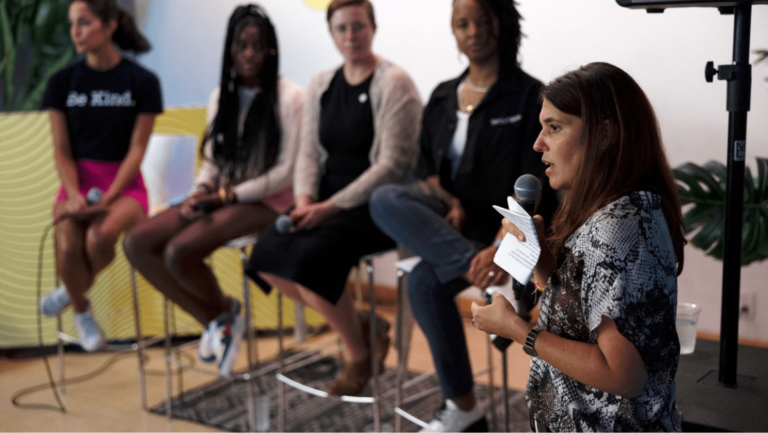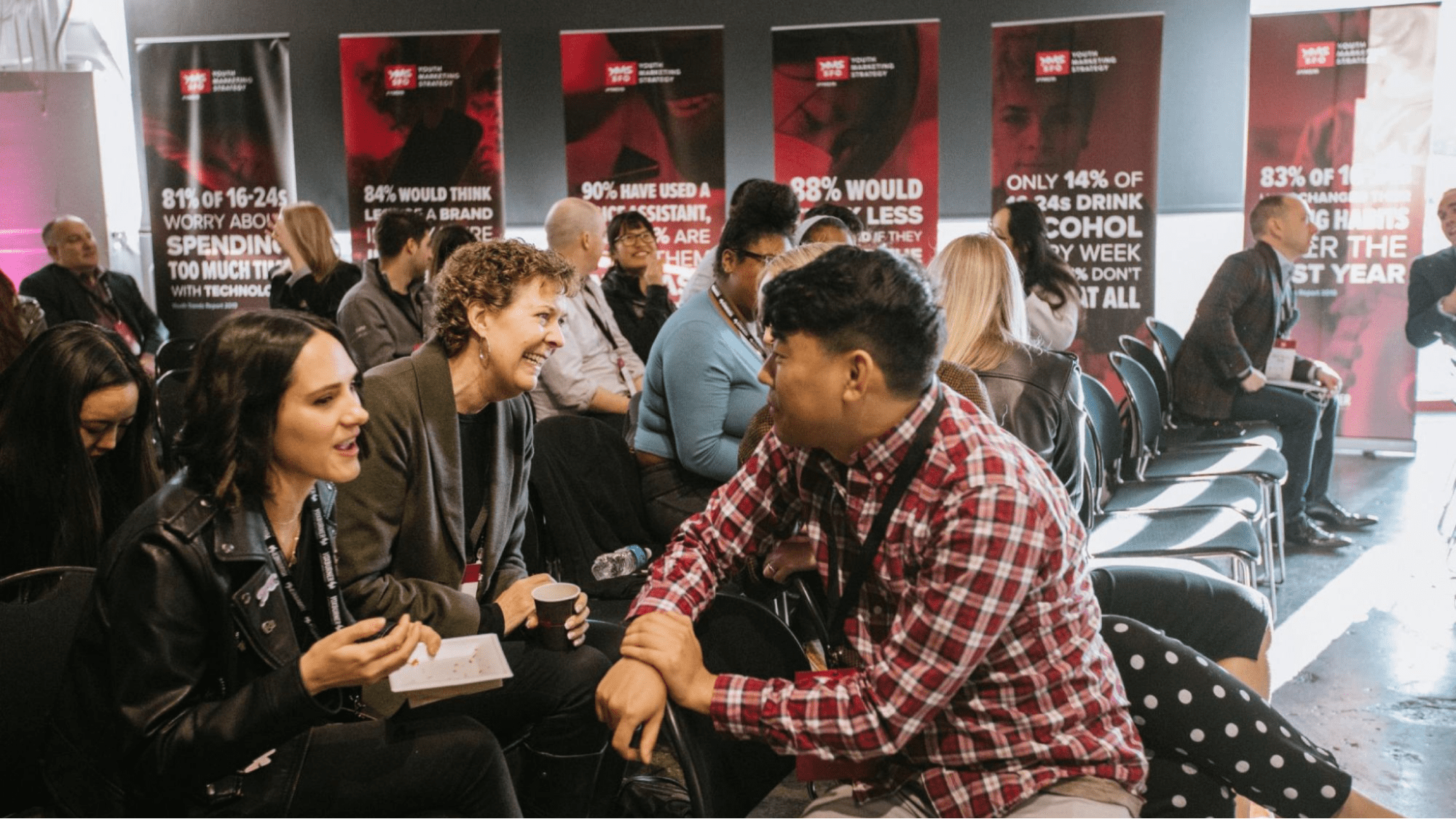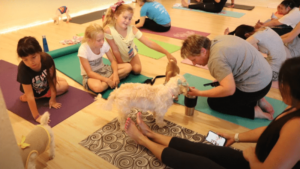Your next event could shape how your attendees live and work.
Or maybe your audience will just forget it, as they do with so many other events.
What separates the two? Intentional, engaging event design. Fortunately, Eventbrite is here to make sure your event is unforgettable.
We’ve taken a look at the audience engagement strategies that our top event creators use and distilled them here for your benefit. From innovative technology to a surprising touch of humor, you have a wide variety of tools at your disposal. Read on to learn how to make your event something attendees will remember for years to come.

1. Get participants in their bodies
The traditional presentation format isn’t the most exciting. You can encourage the speakers at your events to ditch the slide deck and curate a hands-on session designed to get participants out of their heads and into their bodies.
Set up your event with spaces for people to sit, stand, chat, or even stretch out, and you may notice they’re more engaged, participate more, and feel more involved overall..
When Sandra Tribioli organized the Grow 2024 yoga expo, she made sure it wouldn’t just be speakers and Q&As. Appropriately, it’ll have plenty of yoga workshops, and even some dancing.
Keeping your audience focused can be even more challenging if you’re hosting a virtual event. In fact, 61% of event professionals surveyed said virtual attendee engagement is their biggest challenge.
For virtual audiences, brevity is often key — keep each section or breakout brief, and keep things moving along. Your audience will feel the difference.
2. Prepare speakers to engage the audience
Even experienced speakers get nervous about public speaking sometimes and can have a hard time connecting with the audience.
That’s why it’s so important to prepare your speakers with built-in audience participation activities.
These issues can be magnified during a virtual event, where the audience is already physically removed from the speaker. To bridge the distance between the speaker and the audience, it helps to make your speaker as comfortable as possible.
Ensure that your speaker is familiar with any tools and technology involved in the presentation. If they have tools they can use for audience interaction, speakers need to feel confident using them. Even better, do a quick run-through before the event, which can double as a check of your tech equipment.
For hybrid events, gently remind your speaker to engage virtually as well as with your live attendees.
For example, when Access Silicon Valley organized their Keynote and Q&A with Rajesh Swaminathan, they took questions through Twitter before and during the event. That’s a lot to manage at once, and they had to be sure their speaker understood where the questions were coming from and how to access them.

3. Use icebreakers to make the audience more comfortable
When you’re kicking off your event, you want to engage your audience right away. There are a variety of tried-and-true methods to break the ice.
- The show of hands: Have your speakers prepare a question or two to ask right off the bat. This is a classic for drawing in the audience.
- The voluntary share: Ask for volunteers to share why they’re here and what they hope to get out of the talk.
- The group exercise: Depending on the size of the crowd and how much time a speaker has, a quick group exercise is another great way to get people involved. Don’t be afraid to get creative, like the Central Ohio Chapter of NAHSE did by incorporating line dancing and a game night with their Black Healthcare Professional Networking event.
Virtual formats have their own techniques for connecting speakers with the audience. Consider incorporating custom polls, the Zoom “hand raise,” and breakout rooms — but be careful these don’t interrupt the flow of your presentations.
4. Use tech tools to create conversations
Technology is one way to include audience members who are shy about raising their hands to speak up. It can also create new layers of engagement aside from verbal conversation.
Certain apps allow presenters to conduct live polling of their audience. Presenters ask a question, and participants answer via their mobile devices or through a streaming service, such as Zoom, if your event includes a virtual component. You then display the results in real time on a screen (on stage or virtually).
You can bring that capability into the rest of your event as well. Whether it’s vendors surveying attendees on what demos they want to see ahead of time or a musical act learning what songs the audience wants to hear, live polling can be a great way for everyone’s voice to be heard.
That technology is what brought Maine Revenue Services’ State Tax Symposium into an engaging and interactive experience for everyone. Live polling lets speakers know that their audience is on the same page. At the same time, it helps encourage everyone to pay attention.
Alternatively, you can curate Q&As where the audience members type in their questions. Speakers choose the best ones to answer live — a digital equivalent to a “fireside chat.” It might be a good idea to prepare some Q’s for your Q&A beforehand so if the audience is shy, you are ready to get the session going right away.

5. Come up with prompts that inspire audience participation
Looking directly at a random audience member and asking her a direct question might backfire. Ask questions people want to answer without making them feel like they’re on the spot. Ask questions that spark stories, like “Has anyone had a bad experience with social media they’d like to share?”
Sometimes, a question can be so general that it’s actually rhetorical: “Who remembers their first day of junior high?” Even if you don’t expect a response, questions like this get the audience to reflect, which draws them in. Or reward participants with freebies like t-shirts or coffee gift cards and watch the questions pour in. Consider giving your audience prompts prior to the event to allow them to process their response — when it’s time for questions, they’ll be primed to share.
When Sam and Kaz Keller created their ChatGPT workshop, they knew they’d want to make it interactive. That’s why they built in some fun activities that would inspire responses from their audience, like telling them to prompt ChatGPT to tell a joke. Then, the audience members could share their experiences with smiles on their faces.
6. Plan for all possible responses
When you create audience response events, there’s always a risk you’ll hear answers you didn’t count on. Or, worse, no one will volunteer to raise their hand or share.
Coach your speakers to react quickly when they don’t get the response they expected. Having a ready answer for questions that might stump the audience can be effective. Likewise, a simple, self-effacing quip works wonders, relaxing the audience and revealing an appealing self-confidence at the same time.
This is especially true when you build your event around audience participation and questions. For example, when the Asentiv Ireland Team planned their Winning New Clients Q&A, they needed to make sure they were ready for any possible questions that could come their way.

7. Get attendees’ feedback
Real-time polling apps have another purpose: to get event feedback while it’s still fresh in people’s minds. You can also use an email survey app like SurveyMonkey to ask participants for feedback shortly after it concludes.
To make it super easy, you can import guest lists into your email with Eventbrite’s SurveyMonkey extension.
With a combination of strategic planning and in-the-moment action, you can avoid a one-sided event.
Appropriately, Georgetown University Human Resources’ Building A Healthy Feedback Culture Workshop incorporated plenty of opportunities for audience feedback. From breakout and group discussions to written responses to the workshop, their audience was actively engaged.
8. Help attendees connect
Creating networking opportunities within your event can catalyze meaningful connections among attendees. Incorporate structured networking sessions into your event schedule, such as speed networking rounds allowing individuals to meet several others quickly.
For virtual events, consider utilizing a “breakout rooms” feature on platforms like Zoom to foster small group discussions. Additionally, you can design dedicated “networking zones” in physical events or create virtual “networking lounges” for online attendees.
An event-specific mobile app or online platform can also facilitate connections by enabling attendees to chat, schedule meetings, or share contact information. Lastly, consider hosting social activities such as cocktail hours or themed parties as a part of the event, which provide a more casual atmosphere for attendees to mingle and connect.

9. Consider the ambiance
Believe it or not, the environment of your venue plays a part in how much audience members are willing to participate. Maslow’s Hierarchy of Needs describes the elements necessary for human health and happiness, starting with the basics: food, water, and warmth.
While the framework has been updated more recently, researchers have consistently held that those basic levels are consistent. That’s why people perform better when these basic needs are appropriately met. Make sure the room is warm (but not so warm people fall asleep) and that snacks and water are readily available. Once they’re comfortable, people are more likely to relax and open up.
For virtual events, the concerns have less to do with the physical ambiance but a lot to do with the online environment. You can greet everyone to make them feel comfortable and start with some casual conversation to encourage audience participation early on.
While it is impractical to include all audience members in an online presentation, it does emphasize how important it can be to engage your virtual audience as much as possible since the format inherently creates some distance.
It helps if you build your event around the ambiance. Dynasty Electrik’s crystal sound bath events are always in relaxed, comfortable environments like yoga studios. Of course, the use of powerfully relaxing sounds also helps!
10. Address all learning styles
Learning styles refer to the ways individuals process information, often influencing how they learn best. The most commonly recognized learning styles include:
- Visual: learning through seeing
- Auditory: learning through listening
- Kinesthetic: learning through movement or hands-on experiences
- Reading/writing: learning through written words
Addressing different learning styles in an event setting can significantly enhance attendee engagement. Not everyone absorbs information in the same way. Incorporating diverse methods of information delivery — such as visual displays, spoken presentations, hands-on workshops, and reading materials — caters to the different learning styles, increasing the likelihood that all attendees will grasp and retain the information conveyed.
This approach fosters an inclusive event environment, ensuring that every attendee has the opportunity to fully participate and gain value from the event, thereby improving their overall experience.
That might all sound like a theoretical and complicated approach, but it doesn’t have to be. Fairy Tale Gardens’ recipe workshop involves visual learning from the demonstration, auditory learning from the instruction, kinesthetic learning from hands-on practice, and reading the recipes themselves.

11. Create bite-sized takeaways
Engaging an audience doesn’t end with the event itself — it’s a continuous process, and bite-sized takeaways can play a crucial role. These are small, easily understandable pieces of information or insights that attendees can quickly grasp and remember. They have the power to reinforce the concepts discussed during the event, making the learning experience more effective and enjoyable.
In the pre-event marketing phase, bite-sized takeaways can be shared via social media, newsletters, or event apps to pique interest and give potential attendees a glimpse into the value they can expect from the event. This could be in the form of event highlights, speaker quotes, or infographics that encapsulate key insights.
During the event, these small nuggets of knowledge can be distributed as part of the presentation, as handouts or digital downloads, or even shared via live tweets or event app notifications. They act as reinforcement tools, aiding attendees in assimilating and recalling the information presented to them.
That’s why the South Dakota Department of Social Services’ Division of Public Health made the takeaways from their conference on suicide prevention clear right away. Rather than burying the key insights within a long-form document or leaving attendees to their own devices, they created simple, brief summaries of each session and distributed them online.
Engage your audience from day one with Eventbrite’s marketing tools.

13. Make them laugh
Just adding a little humor to your event can make all the difference. Why? Laughter is not just the best medicine but also a remarkable tool to keep that wandering audience’s focus right on target.
In the words of Stanford Graduate School of Business professor Jennifer Aaker, “showing your sense of humor can make your peers and your friends attribute more perceptions of confidence and status to us while also cultivating a sense of trust.”
To incorporate a little more humor in a presentation, start with something relatable, maybe a funny anecdote or a hilarious work mishap. Keep it light, relevant, and please, no inside jokes — you don’t want to be the only one laughing! Remember, the goal is to make your audience chuckle, not to audition for a Netflix stand-up special.
That’s what makes Get In the Kitchen’s cooking and comedy classes so effective. They keep attendees laughing between cooking demonstrations, making the experience more interactive and entertaining. Everyone leaves having learned something and laughed a lot.

13. Boost social media engagement
Social media engagement is another great way to keep your audience engaged. Posting timely updates, live tweeting sessions, and even inviting audience members to contribute their own questions or topics of discussion are all ways to keep the conversation going.
By advertising your event on social media with tools like the Eventbrite marketing suite, you can build audience engagement online as well as in person. By using social media for events, your attendees can even keep the conversation going afterward!
At Project Voice’s conferences, they make sure to incorporate a dedicated hashtag and encourage interaction with their Twitter account. That way, people can stay connected to the event before, during, and after.
14. Signpost the event
Signposting an event aids in maintaining audience engagement by providing a clear roadmap of the event structure, making it easier for attendees to navigate the various sessions or activities. It allows them to anticipate what’s coming up next, manage their time effectively, and plan their participation accordingly.
Signposts, such as a detailed agenda or an event program, also set expectations upfront, minimizing potential confusion or disappointment and enhancing the overall attendee experience. They also foster a sense of excitement and anticipation toward the event’s upcoming segments or high-profile speakers.
By enabling attendees to fully understand and appreciate the flow of the event fully, signposting contributes to a more engaging and satisfactory event experience. For instance, the Singapore Red Cross’s humanitarian conference came advertised with the exact agenda and detailed information on every item. That keeps the audience engaged and excited for what’s next.
15. Incentivize engagement
Incentivizing engagement with prizes and swag can work wonders to keep the attendees active and invested. Start by integrating contests or games into your event schedule, with prizes awarded to the winners.
These could be trivia quizzes, scavenger hunts, or social media engagement contests such as “best tweet” or “most creative event-related Instagram post.” The prizes can range from branded merchandise and discount vouchers to more valuable gifts like tech gadgets or tickets to future events.
Additionally, offer swag bags as a token of appreciation for attendees’ participation. These can be filled with practical items like branded stationery, water bottles, or t-shirts, or even virtual swag for online events, such as e-books, digital wallpapers, or discount codes for online courses. This incentivizes engagement and extends the event experience beyond its timeline as attendees continue to use and appreciate these items.
The key is to make your incentives relevant and appealing to your audience. For instance, SportsLink’s volleyball events come with prizes like chairs and coolers that players would want to take to volleyball games anyway. That inspires the players to engage fully with the event and maybe even bring in some more people to play.

16. Make your theme coherent
Having a coherent event theme is a strategic approach to captivating your attendees and keeping them engaged. A well-chosen theme provides a unified narrative that ties all the aspects of your event together, creating a seamless and exciting experience for the attendees.
From the visual aesthetics and promotional materials to the content of presentations or workshops, a consistent theme brings harmonization and facilitates understanding. It helps to set the tone of the event, guide the expectations of the attendees, and give them a ready-made topic to connect over.
Moreover, a strong theme can evoke emotions and create a memorable impression, leaving attendees with a lasting connection to your event. That’s what made Foodwise’s spring cocktails event so memorable: With a flowery spring theme, the attendees and vendors alike were left with lasting impressions.
How to include audience feedback before the event begins
Audience engagement is an art that combines multiple strategies, from leveraging technology to acknowledging learning styles to incentivizing participation and maintaining a consistent theme. When used effectively, these methods create an immersive and memorable experience for attendees and nurture a lasting connection with your event
Engaging your audience becomes much easier when you’ve invited the perfect target audience. That’s why Eventbrite Ads are so useful: You can reach people who are already using Eventbrite to find events like yours!






